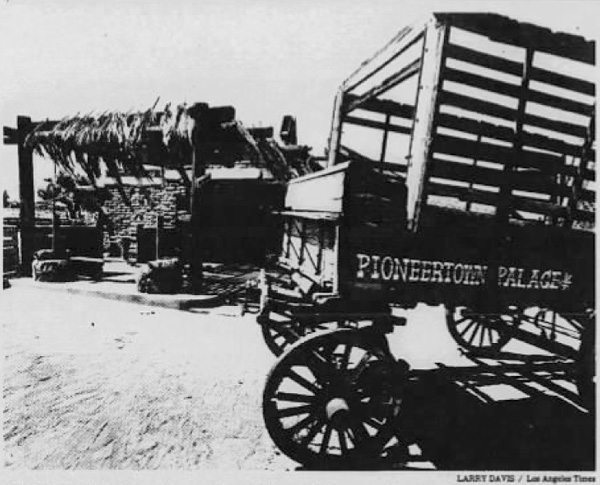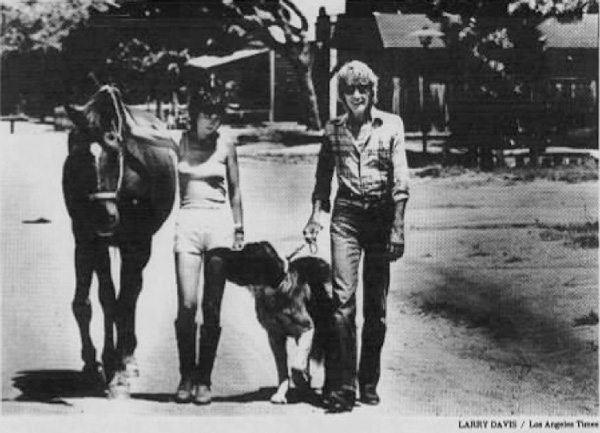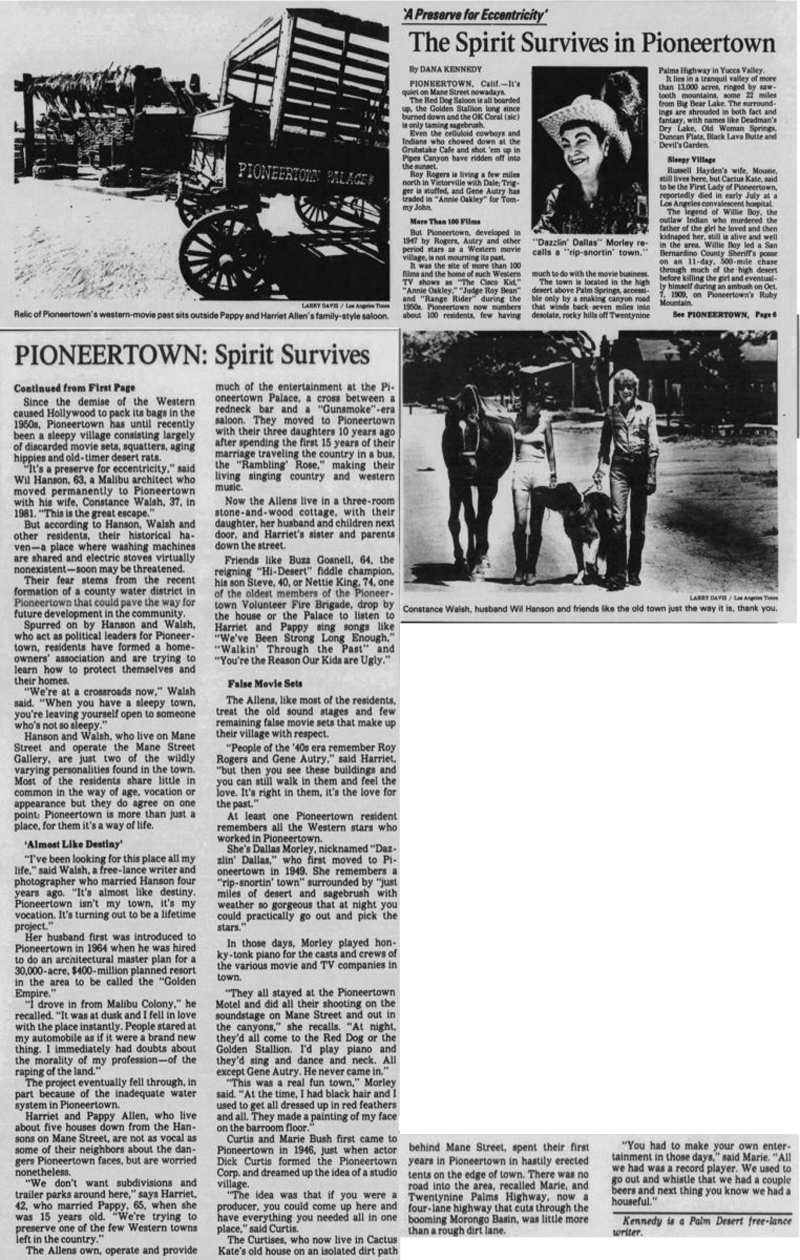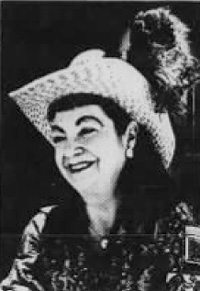‘A Preserve for Eccentricity’

The Spirit Survives in Pioneertown
By DANA KENNEDY
PIONEERTOWN, Calif. – It’s quiet on Mane Street nowadays.
The Red Dog Saloon is all boarded up, the Golden Stallion long since burned down and the OK Corral (sic) is only taming sagebrush.
Even the celluloid cowboys and Indians who chowed down at the Grubstake Café and shot ‘em up in Pipes Canyon have ridden off into the Sunset.
Roy Rogers is living a few miles north in Victorville with Dale; Trigger is stuffed, and Gene Autry has traded in “Annie Oakley” for Tommy John.
But Pioneertown, developed in 1947 by Rogers, Autry and other period stars as a Western movie village, is not mourning its past.
It was the site of more than 100 films and the home of such Western TV shows as “The Cisco Kid,” “Annie Oakley,” “Judge Roy Bean” and “Range Rider” during the 1950s. Pioneertown now numbers about 100 residents, few having much to do with the movie business.
More Than 100 Films
The town is located in the high desert above Palm Springs, accessible only by a snaking canyon road that wind back seven miles into the desolate, rocky hills off Twentynine Palms Highway in Yucca Valley.
It lies in a tranquil valley of more than 13,000 acres, ringed by sawtooth mountains, some 22 miles from Big Bear Lake. The surroundings are shrouded in both fact and fantasy, with names like Deadman’s Dry Lake, Old Woman Springs, Duncan Flats, Black Lava Butte and Devil’s Garden.
Sleepy Village
Russell Hayden’s wife, Mousie, still lives here, but Cactus Kate, said to be the First Lady of Pioneertown, reportedly died in early July at a Los Angeles convalescent hospital.
The legend of Willie Boy, the outlaw Indian who murdered the father of the girl he loved and then kidnaped her, still is alive and well in the area. Willie Boy led a San Bernardino County Sheriff’s posse on an 11-day, 500-mile chase through much of the high desert before killing the girl and eventually himself during an ambush on Oct. 7, 1909, on Pioneertown’s Ruby Mountain.
PIONEERTOWN: Spirit Survives
Continued from First Page
Since the demise of the Western caused Hollywood to pack its bags in the 1950s, Pioneertown has until recently been a sleepy village consisting mostly of discarded movie sets, squatters, aging hippies and old-timer desert rats.
“It’s a preserve for eccentricity,” said Wil Hanson, 63, a Malibu architect who oved permanently to Pioneertown with his wife, Constance Walsh, 37, in 1981. “This is the great escape.”
But according to Hanson, Walsh and other residents, their historical haven—a place where washing machines are shared and electric stoves virtually nonexistent—soon may be threatened.
Their fear stems from the recent formation of a county water district in Pioneertown that could pave the way for future development in the community.

Spurred on by Hanson and Walsh, who act as political leaders for Pioneertown, residents have formed a homeowners’ association and are trying to learn how to protect themselves and their homes.
“We’re at a crossroads now,” Walsh said. “When you have a sleepy little town, you’re leaving yourself open to someone who’s not so sleepy.”
Hanson and Walsh, who live on Mane Street and operate the Mane Street Gallery, are just two of the wildly varying personalities found in the town. Most of the residents share little in common in the way of age, vocation or appearance but they do agree on one point: Pioneertown is more than just a place, for them it’s a way of life.
‘Almost Like Destiny’
“I’ve been looking for this place all my life,” said Walsh, a free-lance writer and photographer who married Hanson four years ago. “It’s almost like destiny. Pioneertown isn’t my town, it’s my vocation. It’s turning out to be a lifetime project.”
Her husband first was introduced to Pioneertown in 1964 when he was hired to do an architectural master plan for a 30,000-acre, $400-million planned resort in the area to be called the “Golden Empire.”
“I drove in from Malibu Colony,” he recalled. “It was dusk and I fell in love with the place instantly. People stared at my automobile as if it were a brand new thing. I immediately had doubts about the morality of my profession—of the raping of the land.”
The project eventually fell through, in part because of the inadequate water system in Pioneertown.
Harriet and Pappy Allen, who live about five houses down from the Hansons on Mane Street, are not as vocal as some of their neighbors about the dangers Pioneertown faces, but are worried nonetheless.
“We don’t want subdivisions and trailer parks around here,” says Harriet, 42, who married Pappy, 65 when she was 15 years old. “We’re trying to preserve one of the few western towns left in the country.”
The Allens own, operate and provide much of the entertainment at the Pioneertown Palace, a cross between a redneck bar and a “Gunsmoke”-era saloon. They moved to Pioneertown with their three daughters 10 years ago after spending the first 15 years of their marriage traveling the country in a bus, the “Rambling’ Rose,” making their living singing country and western music.
Now the Allens live in a three-room stone-and-wood cottage, with their daughter, her husband and children next door, and Harriet’s sister and parents live down the street.
Friends like Buzz Goznell, 64, the reigning “Hi-Desert” fiddle champion, his son Steve, 40, or Nettie King, 74, one of the oldest members of the Pioneertown Volunteer Fire Brigade, drop by the house or the Palace to listen to Harriet and Pappy sing songs like “We’ve Been Strong Long Enough,” “Walkin’ Through the Past” and “You’re the Reason Our Kids are Ugly.”
False Movie Sets
The Allens, like most residents treat the old sound stages and few remaining false movie sets that make up their village with respect.
“People of the ‘40s era remember Roy Rogers and Gene Autry,” said Harriet, “but then you see these buildings and you can still walk in them and feel the love. It’s right in them, it’s the love for the past.”
At least one Pioneertown residents remembers all the Western stars who worked in Pioneertown.
She’s Dallas Morley, nicknamed “Dazzlin’ Dallas,” who first moved to Pioneertown in 1949. She remembers a “rip-snortin’ town” surrounded by “just miles of desert and sagebrush with weather so gorgeous that at night you could practically go out and pick the stars.”
In those days, Morley played honky-tonk piano for the casts and crews of the various movie and TV companies in town.
“They all stayed at the Pioneertown Motel and did all their shooting on the soundstage on Mane Street and out in the canyons,” she recalls. “At night they’d all come to the Red Dog or the Golden Stallion. I’d play piano and they’d sing and dance and neck. All except Gene Autry. He never came in.”
“This was a real fun town,” Morley said. “At the time, I had black hair and I used to get all dressed up in red feathers and all. They made a painting of my face on the barroom floor.”
Curtis and Marie Bush came to Pioneertown in 1946, just when actor Dick Curtis formed the Pioneertown Corp. and dreamed up the idea of a studio village.
“The idea was that if you were a producer, you could come up here and have everything you needed all in one place,” said Curtis.
The Curtises, who now live in Cactus Kate’s old house on an isolated dirt path behind Mane Street, spent their first years in Pioneertown in hastily erected tents on the edge of town. There was no road into the area, recalled Marie, and Twentynine Palms Highway, now a four-lane highway that cuts through to booming Morango Basin, was little more than a rough dirt lane.
“You had to make your own entertainment in those days,” said Marie. “All we had was a record player. We used to go out and whistle that we had a couple of beers and the next thing you know we had a houseful.”
–Kennedy is a Palm Desert free-lance writer.


